In APL Bioengineering, researchers develop an injectable hydrogel that treats infections around prosthetics without the problems caused by current treatments. The black phosphorus-enhanced gel has a porous structure, excellent injectability, and rapid self-healing properties. Tests show it has good stability and low toxicity to tissue cells, and irradiating the gel with near infrared light causes it to release silver ions. This process was highly efficient at inhibiting S. aureus, common bacteria that cause disease in humans.



